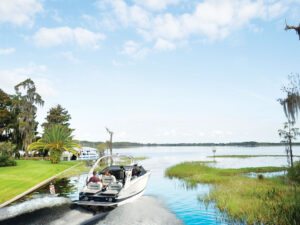Hurricane Sandy secured its place in history in October 2012, affecting people in seven countries. When it took a sharp, almost-unheard-of left turn and slammed into the Jersey shore, it pushed a 14-foot storm surge into New York Harbor at high tide. Gadi Zofi, operations manager and spill supervisor for Ken’s Marine Service in Bayonne, New Jersey, had a front-row seat for the action. Months later, his team is still cleaning up the worst-hit areas.
Had you experienced a hurricane prior to Sandy?
I’ve spent all my life on the water, and I’ve never been in a hurricane. It was quite an experience. The docks floated over the pilings, and the surge tore the moorings apart. In the beginning, we were trying to save our fleet of about 30 workboats. We put steel pipes through the spuds on a barge so it would ride up and down, and we rafted all the boats together. We didn’t lose any boats or equipment.
Does one particular memory stand out?
On the morning of the storm, a Hatteras was dragging its mooring. It was full of fuel, and we didn’t want it to crash on the rocks. The wind was already 50 to 60 mph. We took an inflatable out there, got on board and took the boat off the mooring. The boat was too big for the local yacht club, so we drove into the wide upper bay, heading for the Liberty Landing Marina. The U.S. Coast Guard had raised conditions from X-ray to Zulu, which are hurricane conditions. There was no vessel movement in the harbor, and we were on a pleasure boat!
Did you save the boat?
A municipal marina was our last resort, but it said it had no room. The police came down, and the chief said, get the boat out of here or get arrested. That’s the only time I’ve ever had handcuffs on! But it was temporary; the mayor’s office made arrangements, and the boat survived with minimal damage.
What have you been doing since the hurricane?
We’ve picked up heating oil that floated off houses. We’ve worked on cleanup in the Rockaways, at Breezy Point, in Jamaica Bay, at the Statue of Liberty, at Ellis Island, at Liberty State Park. We’ve been defueling boats. Many were put on barges and sent to a staging area on Staten Island, where some were collected and others left derelict. There’s a lot involved to make a boat stable and keep it afloat, so some boats were defueled and put back down. And there are still boats and ships out there that need to be dealt with.
Have you needed to do any diving?
We try to rig slings without diving if possible, but I’ve dived on a few boats. In places like the Hudson River, Great Kills and Jamaica Bay the water temperature is about 40 degrees, and visibility is a foot, if that. And if you touch anything, visibility goes to nothing.
What are the conditions at marinas?
The big ones are all destroyed, except for Liberty Landing. The mooring fields have lost all their moorings. There may be fewer boats in the region right now, but for those who do have boats, there’s no place to put them. We have a long way to go.
In your two decades with Ken’s Marine Service, have you had other experiences that might qualify as once-in-a-lifetime?
On 9/11, I used a tugboat to help evacuate people from Manhattan. I was supposed to transport the injured to NYU, but in the end, there was no one to transport. I also was on the scene with the owner of Ken’s Marine after US Airways Flight 1549 landed on the Hudson River. We assisted it as the airplane floated downriver. It was ebb tide, and it was on its way to the bay.









